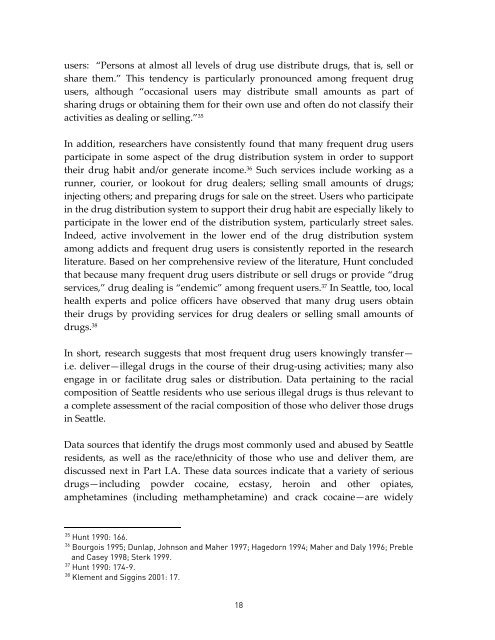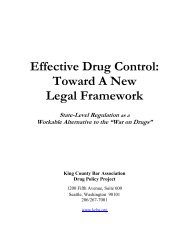RACE AND THE ENFORCEMENT OF DRUG DELIVERY LAWS IN ...
RACE AND THE ENFORCEMENT OF DRUG DELIVERY LAWS IN ...
RACE AND THE ENFORCEMENT OF DRUG DELIVERY LAWS IN ...
You also want an ePaper? Increase the reach of your titles
YUMPU automatically turns print PDFs into web optimized ePapers that Google loves.
users: “Persons at almost all levels of drug use distribute drugs, that is, sell or<br />
share them.” This tendency is particularly pronounced among frequent drug<br />
users, although “occasional users may distribute small amounts as part of<br />
sharing drugs or obtaining them for their own use and often do not classify their<br />
activities as dealing or selling.” 35<br />
In addition, researchers have consistently found that many frequent drug users<br />
participate in some aspect of the drug distribution system in order to support<br />
their drug habit and/or generate income. 36 Such services include working as a<br />
runner, courier, or lookout for drug dealers; selling small amounts of drugs;<br />
injecting others; and preparing drugs for sale on the street. Users who participate<br />
in the drug distribution system to support their drug habit are especially likely to<br />
participate in the lower end of the distribution system, particularly street sales.<br />
Indeed, active involvement in the lower end of the drug distribution system<br />
among addicts and frequent drug users is consistently reported in the research<br />
literature. Based on her comprehensive review of the literature, Hunt concluded<br />
that because many frequent drug users distribute or sell drugs or provide “drug<br />
services,” drug dealing is “endemic” among frequent users. 37 In Seattle, too, local<br />
health experts and police officers have observed that many drug users obtain<br />
their drugs by providing services for drug dealers or selling small amounts of<br />
drugs. 38<br />
In short, research suggests that most frequent drug users knowingly transfer—<br />
i.e. deliver—illegal drugs in the course of their drug-using activities; many also<br />
engage in or facilitate drug sales or distribution. Data pertaining to the racial<br />
composition of Seattle residents who use serious illegal drugs is thus relevant to<br />
a complete assessment of the racial composition of those who deliver those drugs<br />
in Seattle.<br />
Data sources that identify the drugs most commonly used and abused by Seattle<br />
residents, as well as the race/ethnicity of those who use and deliver them, are<br />
discussed next in Part I.A. These data sources indicate that a variety of serious<br />
drugs—including powder cocaine, ecstasy, heroin and other opiates,<br />
amphetamines (including methamphetamine) and crack cocaine—are widely<br />
35<br />
Hunt 1990: 166.<br />
36 Bourgois 1995; Dunlap, Johnson and Maher 1997; Hagedorn 1994; Maher and Daly 1996; Preble<br />
and Casey 1998; Sterk 1999.<br />
37 Hunt 1990: 174-9.<br />
38<br />
Klement and Siggins 2001: 17.<br />
18

















